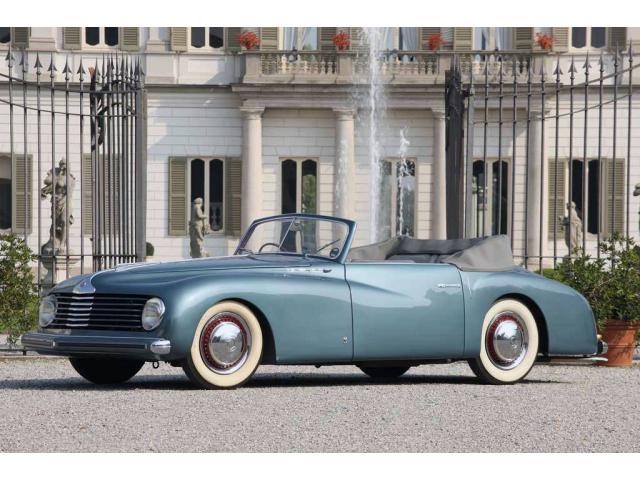1947 Alfa Romeo 6C 2500 S Stabilimenti Farina Cabriolet
- Brand: Alfa Romeo
1947 Alfa Romeo 6C 2500 S Stabilimenti Farina Cabriolet
Introduced in 1939, the Alfa Romeo 6C 2500 was the result of over a decade of gradual development of the '6C'. Starting in 1927 with the 6C 1500, the six cylinder engined machines had served as Alfa Romeo's main production model but also scored numerous competition successes. The 6C 2500 would remain in Alfa's line-up until 1952 and is to this day regarded as one of the company's finest cars.
The main distinguishing feature compared to the outgoing 6C 2300 was the enlarged engine. This twin overhead camshaft straight six, originally designed by the legendary Vittorio Jano, grew in size from 2309 cc to 2443 cc courtesy of a slightly larger bore. It was available equipped with either one or three Weber carburettors. The triple was used for the top of the range 6C 2500 ss model, which also featured a high-compression head. In that specification, the engine produced a quoted 110 bhp.
Mated to a four-speed gearbox, the new engine was mounted in the existing steel ladder frame chassis. As before the suspension was fully independent, using twin trailing arms at the front and swing axles at the rear. Stopping power was provided by sizeable, hydraulically actuated drum brakes. The rolling chassis was available in three lengths; 3250 mm on the 'Turismo', 3000 mm on the 'Sport' and 2700 mm on the 'Super Sport'. A choice of companies offered coach-work for the 6C 2500.
In addition to the production road car, Alfa Romeo also developed a competition version for long distance events like the Mille Miglia and the 24 Hours of Le Mans. It featured an even higher compression and larger fuel tank and was known internally as the Tipo 256 for its displacement and number of cylinders. Although not victorious in the big races, the eight cars built scored several wins, most notably in the 1939 Tobrouk-Tripoli road rally. Sadly none have survived in their original condition.
6C 2500s kept rolling off the line well into the War but production eventually ceased in 1942. Alfa Romeo managed to safely store all the tools and moulds, so by 1946 the factory was already up and running again. There were no resources for major developments and the only difference was the adoption of lower compression heads to cope with the poor quality of the fuel available. From 1947 a column mounted gear-lever was fitted. In those early post-War years the 6C 2500 was the most expensive car available.
A majority of the 6C 2500s produced were clothed by Touring of Milan. The designs of their bodies evolved much faster than Alfa Romeo's chassis, making it very easy to distinguish the pre and post-War machines. The most famous is no doubt the two-door coupe that won the 1949 Concorso d'Eleganza Villa d'Este and was subsequently known as the Villa d'Este Coupe. Another body of note was the 'Freccia d'Oro' introduced in 1947. This large two-door coupe was welded to the chassis and was a precursor to the unitary chassis that would soon become the norm.
As early as 1948, Alfa Romeo developed a three litre replacement but this was eventually discarded for economic reasons; there was a much bigger market for a more affordable four-cylinder model. So when the final 6C 2500 rolled off the line in 1952, it truly was the end of an era. Accordingly, the 6C 2500 remains as the last of the great Alfa Romeos that dominated on road and track during the 1930s and 1940s.
Descriptions & pictures by ultimatecarpage & Other links
| Specification | |
| Production Start | 1947 |
| Country of origin | Italy |































